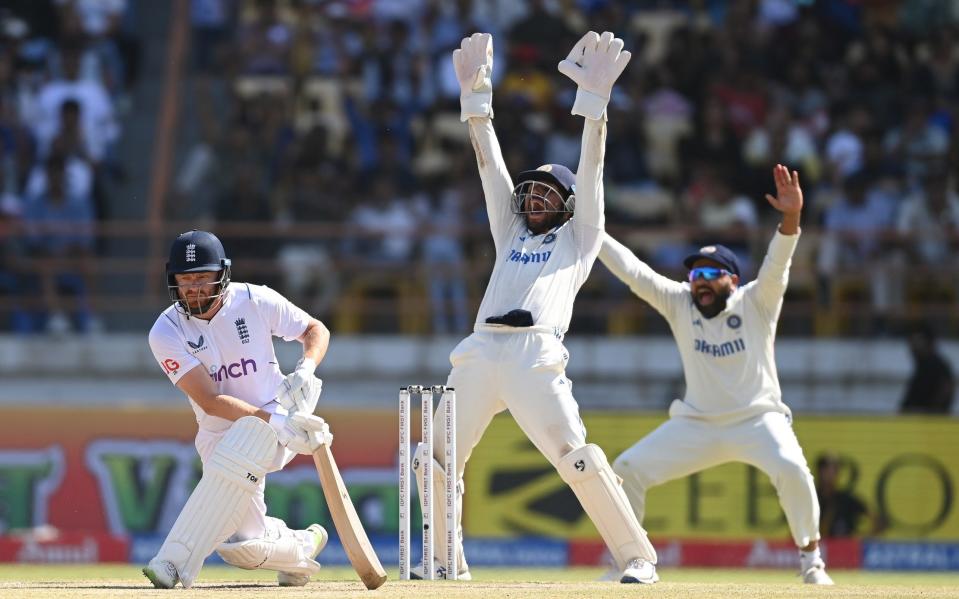
In a corner of the Trent Bridge dressing room, Jonny Bairstow addressed a mirror. “Jonathan Marc Bairstow!” he bellowed. “This is your day, your chance to show what you can do.”
Full, undiluted Bazball was about to be unleashed for the first time. In June 2022, the Test against New Zealand was in the balance at tea: England needed 160 from 38 overs with six wickets in hand. Then, spurred on by a ham and cheese toastie and his pep talk, as recounted in the book Bazball, Bairstow thrashed 93 from his next 44 balls, a blur of power, pristine timing and hooked sixes over fine leg.
It was the prelude to one of the most extraordinary stints by an England batsman in Test history. Over five consecutive innings in three weeks, Bairstow unfurled scores of 136, 162, 71 not out, 106 and 114 not out: 589 runs at an average of 196 and a strike rate of 102. Here was the simplest distillation of what Bazball could mean: how by empowering cricketers to play with elan, uninhibited by the fear of failure, it could liberate them to explore their full potential. Playing as a specialist batsman at No 5, Bairstow’s brief from Brendon McCullum was: “Go out and whack it.”

These exhilarating performances have underpinned England’s faith in Bairstow ever since. After breaking his leg in three places while falling on a golf course in September 2022, Bairstow feared he might not be able to walk again.
Instead, Bairstow returned for the Ashes series, regaining the keeping gloves too. In English cricket’s eternal debate, between prioritising wicketkeeping or batting, his performances provided ample evidence for both sides. Bairstow averaged 40 with the bat, making runs from No 7 at a rollicking rate. But Bairstow also missed six stumping or catching chances in the first three Tests.
Ben Foakes’s return in India, combined with Harry Brook’s withdrawal from the series, meant that Bairstow lost the gloves. The hope was that returning to No 5 could help Bairstow regain his magnificent form of the summer of 2022, which included twin tons against India at Edgbaston. Instead, the sight of Bairstow falling leg-before trying to sweeping his third ball on the fourth evening in Rajkot continued his troubled tour.
To go with his second innings four, Bairstow was out for a duck in the first innings, that time leg before playing back. He is only averaging 17 in three Tests this series, extending his travails in India: Bairstow averages just 25.8 in 11 Tests here, an underwhelming return for a man often hailed as among England’s finest players of spin. His batting travails predate this tour: Bairstow only averaged 23.9 in England’s torrid World Cup defence.
And so the questions about Bazball’s first flag-bearer have become increasingly inescapable.
As a three-format player aged 34, who has kept wicket for the bulk of his professional career, Bairstow’s schedule is among the busiest in world cricket. Only Bairstow and Joe Root, who is also well below his best, played every Ashes Test, every game of the World Cup and every Test in India so far. Uniquely among English cricketers this winter, Bairstow is travelling to India for the World Cup, this five-match Test series and then the Indian Premier League: perhaps the toughest challenges in each of the main three formats of the game. Bairstow will scarcely be home from the IPL before the Twenty20 World Cup: a reminder of the need for England not to overburden him. Root and Jos Buttler, two of Bairstow’s contemporaries, are each no longer picked for one international format; Stokes’s schedule is carefully managed outside of Tests and World Cups.
England’s reserve batsman in India is Dan Lawrence, whose last Test was immediately before Stokes and McCullum took over. Lawrence bats with an unorthodoxy and aggression that seems a natural fit with the regime, and also offers auxiliary off-spin. Yet Bairstow’s average of 48 under Stokes, his history of often being at his best when under scrutiny, and the importance of continuity of selection in encouraging audacious cricket, means that it would be a considerable surprise if he does not retain his berth in Ranchi.
But, however Bairstow fares for the rest of the series, the No 5 berth is only his on short-term rent, until Brook returns. With Ollie Pope ensconced at No 3, then Joe Root at No 4 and Ben Stokes at No 6, England’s first-choice middle order for the medium-term is unusually settled. Barring any absences, there is no room for Bairstow in it.
All being well, Bairstow will play his 100th Test in Dharamshala. Yet somehow it would be fitting if Bairstow celebrated the landmark against a backdrop of uncertainty over his role: above all, the question of whether he should take the gloves or not. Over 12 years as a Test cricketer, Bairstow has scarcely been free from this debate; unusually, he averages more when keeping than as a specialist batsman.
For all Foakes’s magnificence behind the stumps this series, his Test average has now dipped below 30: an uncomfortable place for any wicketkeeper since Adam Gilchrist made his debut 25 years ago. England’s next Test summer, then, is shaping up to begin with the same question as the last. Should it be Foakes behind the stumps, or Bairstow?
Article courtesy of
Source link